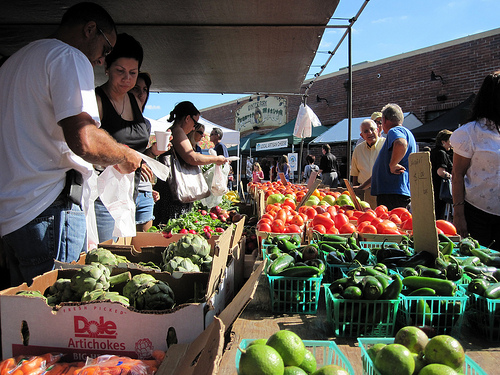
Share On Social!
This is part of our Food and Latino Kids: A Research Review »
Federal food assistance
Research on the impacts of healthy food financing initiatives among SNAP and WIC participants is important because a large proportion of them are Latino, and/or belong to communities impacted by non-medical drivers of health.
Latinos comprise 19 percent of SNAP and 32 percent of WIC participants.36,37
About 50 percent of U.S. Latino children are served by the WIC program.37
Efforts to promote healthier food via federal food assistance
In 2009, the U.S. government revised the “package” of food eligible for WIC food to include a wider variety of healthy foods, including whole grains, fruits and vegetables, and lower-fat milk.
Three studies found that the new WIC food package significantly improved the availability and variety of healthy foods sold in WIC-authorized stores and, to a smaller degree, even non-WIC convenience and grocery stores.38–40
Latinos benefit from these changes
One study showed that the WIC revisions made fresh vegetables more affordable in predominately Latino neighborhoods.41
Using pre- and post-revision store inventories to assess how the new WIC food package affected access to healthy foods in convenience and grocery stores in the state of Connecticut, a study found that the supply of healthy foods increased by 39 percent in lower-income areas. Moreover, improved availability and variety of whole-grain products were responsible for a majority of the increase in the healthy food supply.38
Another cross-sectional study of small, WIC-authorized food stores in eight U.S. major cities found that after WIC was revised, store managers reported increases in their sales of new WIC-approved foods, such as whole-grain bread, low-fat milk, and white-corn and whole-wheat tortillas.40 Although this study did not find changes in sales of processed fruits and vegetables, a pilot program implemented in New York State documented that the vegetable and fruit WIC vouchers were popular among stores that accepted them.42
The revised WIC food package also appears to be changing the diets of participating Latino and other children.
A longitudinal study of Chicago children observed a significant decrease in fat consumption and increases in fruit intake and dietary fiber among participating Hispanic children in Chicago 18 months after the WIC package revisions.30
A cross-sectional study, using a sample of California WIC participants, found an increase in whole grain foods, low-fat milk, and fruits and vegetables 6 months after the implementation of WIC revisions.43
Another cross-sectional study of children aged 2-4 in New York state found a 3 percent increase in consumption of low-fat or nonfat milk and steady increases in daily consumption of fruits, vegetables, and whole grains after the WIC revision was implemented. In the same study, the proportion of children aged 1-2 years and 2-4 years who were obese decreased by 6 and 3 percent, respectively.44
In contrast to WIC, SNAP benefits subsidize broad categories of foods and are not restricted to healthier options within those categories.
Two cross-sectional studies and one short-term longitudinal study found that participation in SNAP does not appear to improve the nutritional quality of adult or children’s diets.45–47
There are conflicting findings on whether participation in SNAP makes children more likely to become obese.48
One study found that Latino women participating in SNAP were 4.5 times more likely to have a child in the 85th percentile for weight than non-participants.49 However, a different study found that participation in SNAP significantly reduces BMI percentile and the likelihood for being overweight/obese for boys and girls ages 5-11 and boys ages 12-18.50
More from our Food and Latino Kids: A Research Review »
- Introduction & Methods
- Key Research Finding: Access to healthy food
- Key Research Finding: Supermarkets
- Key Research Finding: Farmers Markets
- Key Research Finding: WIC and SNAP (this section)
- Key Research Finding: Corner stores
- Key Research Finding: Marketing of unhealthy food
- Policy Implications
- Future Research Needs
References for this section »
(36) SNAP to Health! SNAP: Frequently Asked Questions.
(37) Geller, D.; Harrington, M.; Huang, G. National Survey of WIC Participants II: Participant Characteristics Report; 2012.
(38) Andreyeva, T.; Luedicke, J.; Middleton, A. E.; Long, M. W.; Schwartz, M. B. Positive Influence of the Revised Special Supplemental Nutrition Program for Women, Infants, and Children Food Packages on Access to Healthy Foods. J. Acad. Nutr. Diet. 2012, 112 (6), 850–858.
(39) Han, E.; Powell, L. M.; Isgor, Z. Supplemental Nutrition Assistance Program and Body Weight Outcomes: The Role of Economic Contextual Factors. Soc. Sci. Med. 2012, 74 (12), 1874–1881.
(40) Ayala, G. X.; Laska, M. N.; Zenk, S. N.; Tester, J.; Rose, D.; Odoms-Young, A.; McCoy, T.; Gittelsohn, J.; Foster, G. D.; Andreyeva, T. Stocking Characteristics and Perceived Increases in Sales among Small Food Store Managers/owners Associated with the Introduction of New Food Products Approved by the Special Supplemental Nutrition Program for Women, Infants, and Children. Public Health Nutr. 2012, 15 (9), 1771–1779.
(41) Zenk, S. N.; Powell, L. M.; Odoms-Young, A. M.; Krauss, R.; Fitzgibbon, M. L.; Block, D.; Campbell, R. T. Impact of the Revised Special Supplemental Nutrition Program for Women, Infants, and Children (WIC) Food Package Policy on Fruit and Vegetable Prices. J. Acad. Nutr. Diet. 2014, 114 (2), 288–296.
(42) New York State Department of Health. New York City Healthy Bodegas Initiative: 2010 Report; 2010.
(43) Whaley, S. E.; Ritchie, L. D.; Spector, P.; Gomez, J. Revised WIC Food Package Improves Diets of WIC Families. J. Nutr. Educ. Behav. 2012, 44 (3), 204–209.
(44) Chiasson, M. A.; Findley, S. E.; Sekhobo, J. P.; Scheinmann, R.; Edmunds, L. S.; Faly, A. S.; McLeod, N. J. Changing WIC Changes What Children Eat. Obesity (Silver Spring). 2013, 21 (7), 1423–1429.
(45) Leung, C. W.; Blumenthal, S. J.; Hoffnagle, E. E.; Jensen, H. H.; Foerster, S. B.; Nestle, M.; Cheung, L. W. Y.; Mozaffarian, D.; Willett, W. C. Associations of Food Stamp Participation with Dietary Quality and Obesity in Children. Pediatrics 2013, 131 (3), 463–472.
(46) Leung, C. W.; Cluggish, S.; Villamor, E.; Catalano, P. J.; Willett, W. C.; Rimm, E. B. Few Changes in Food Security and Dietary Intake from Short-Term Participation in the Supplemental Nutrition Assistance Program among Low-Income Massachusetts Adults. J. Nutr. Educ. Behav. 2014, 46 (1), 68–74.
(47) Nguyen, B. T.; Shuval, K.; Njike, V. Y.; Katz, D. L. The Supplemental Nutrition Assistance Program and Dietary Quality among US Adults: Findings from a Nationally Representative Survey. Mayo Clin. Proc. 2014, 89 (9), 1211–1219.
(48) Richards, M. R.; Sindelar, J. L. Rewarding Healthy Food Choices in SNAP: Behavioral Economic Applications. Milbank Q. 2013, 91 (2), 395–412.
(49) Watt, T. T.; Appel, L.; Roberts, K.; Flores, B.; Morris, S. Sugar, Stress, and the Supplemental Nutrition Assistance Program: Early Childhood Obesity Risks among a Clinic-Based Sample of Low-Income Hispanics. J. Community Health 2013, 38 (3), 513–520.
(50) Schmeiser, M. D. The Impact of Long-Term Participation in the Supplemental Nutrition Assistance Program on Child Obesity. Health Econ. 2012, 21 (4), 386–404.
Explore More:
Healthy FoodBy The Numbers
1
Supermarket
for every Latino neighborhood, compared to 3 for every non-Latino neighborhood



